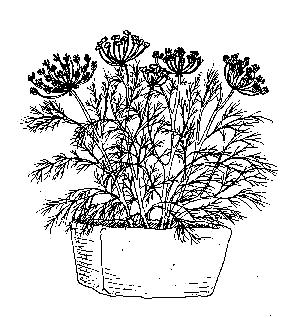Dill, a member of the carrot family, has been a favorite culinary herb for centuries. It is valued both for its flavorful foliage and for its pungent seeds. The name “dill” comes from an old Norse word, “dilla,” which means “to lull,” this plant having been prescribed as a remedy for insomnia.
Dill is a delightful herb with many culinary uses. Allowed to flower in the garden it also supports lots of beneficial insects including bees, parasitic wasps, and tachinid flies. Planted in orchards, it attracts insects that control codling moths and tent caterpillars.
Most varieties of dill are annuals--the plants die each year, but their seeds winter over in the soil to pop up the following year--everywhere! Dill grows everywhere in the US and southern Canada.
Size: Common garden dill grows 3 to 5 feet tall, but dwarf versions grow from 24 to 36 inches tall.
 |
Foliage: The term “dillweed” refers to the feathery, bluish green dill foliage. Multiple fronds branch readily from the single round, hollow main stem per root. The fine, thin leaves are best harvested first from the outside of the plant. Dill generates new foliage as long as the main stem is not cut.
Flowers: Tiny yellow dill flowers bloom in flat clusters and then turn into dark brown seeds. Plant dill in early spring for flowering in July.
Using Dill in the Landscape
 |
Plant dill in an herb patch near the kitchen or in containers such as windowboxes or planters. Use it with other ornamental plants, so its ferny foliage can provide a soft background for smaller annual and perennial flowers. Dill is an excellent plant for attracting bees and other beneficial insects, so wherever it is planted it contributes to the welfare of its neighboring plants.

